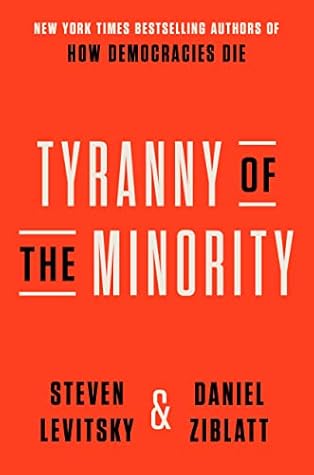More on this book
Community
Kindle Notes & Highlights
Read between
May 20 - May 24, 2025
Unlike earlier “racial orders,” which were marked by clear boundaries between ethnic groups and established racial hierarchies (with whites on top), the changes of the late twentieth and early twenty-first centuries blurred ethnic and racial boundaries and weakened racial hierarchies. These changes manifested themselves in numerous ways, including growing representation of nonwhites and mixed-raced families on television and movie screens; mounting challenges in classrooms and newsrooms to long-established historical narratives that downplayed or ignored America’s racist past; and declining
...more
“We’re not generating enough angry white guys to stay in business for the long term.”
Under President George W. Bush, the Justice Department launched an unprecedented effort to identify and punish cases of voter fraud. They found almost no cases.
According to one analysis, Republican legislators “gathered…data on the types of identification blacks had and didn’t have, and then tailored the list of vote-worthy IDs to favor whites.”
This was lawfare—legislation that was ostensibly aimed at combating fraud but in reality was designed to dampen turnout among lower-income, minority, and young voters.
This racial hierarchy guaranteed white Americans a certain minimum standing in society—a “glass floor below which the white citizen could see but never fall.” W.E.B. Du Bois called this the “psychological wage” of whiteness. For nearly two hundred years, this racial hierarchy was taken for granted.
The leveling of long-standing social hierarchies generated a sense of unfairness among many whites. When one grows up with a certain guaranteed standing in society, the loss of that special status can feel like an injustice. Indeed, many white Americans began to feel like victims.
On election night in 2012, the Fox News host Bill O’Reilly declared that “the white establishment is now the minority….It’s not traditional America anymore.”
As Ezra Klein aptly put it, “Trump didn’t hijack the Republican Party. He understood it.”
Many Trump supporters also embraced the “great replacement theory,” which claimed that a cabal of elites was using immigration to replace America’s “native” white population.
South Carolina’s senator Lindsey Graham called Georgia’s secretary of state, Raffensperger, and asked whether he could disqualify all mail-in ballots in counties with high rates of signature mismatches—potentially turning the election in that state.
Holding Trump accountable for January 6 was not in Cheney’s short-term self-interest. After voting to impeach Trump, she received hundreds of death threats and was removed from the House Republican leadership, expelled from the Wyoming Republican Party, censured by the Republican National Committee, and defeated in a primary by a Trump-backed challenger. Loyalty to democracy derailed her political career.
Most Republican leaders acted as semi-loyal democrats.
When it became clear that most Republican voters remained loyal to Trump, however, GOP leaders reverted to appeasement. McCarthy underwent a “head-snapping reversal,” ceasing all criticism of Trump’s antidemocratic behavior and soon visiting him at Mar-a-Lago. In the end, McCarthy was among the 197 House Republicans who voted against impeachment, and McConnell joined the 43 of 50 Senate Republicans who voted for acquittal. Led by McConnell, Republican senators blocked the creation of an independent commission to investigate the January 6 insurrection. This was textbook semi-loyalty.
McCarthy and McConnell did not actively seek to undermine democracy; they simply prioritized their career goals over its defense.
The dismantling of the Voting Rights Act makes plain a simple fact: many of America’s venerated political institutions are not very democratic; indeed, they were not made for democracy.
But the problem is not just when the Constitution was written; it’s also how it was written. Many Americans revere the Constitution as a virtually unassailable document. They view counter-majoritarian institutions like the Senate and the Electoral College as part of a carefully calibrated system of checks and balances designed by extraordinarily prescient leaders. This is a myth.
The historian Alexander Keyssar calls the Electoral College a “consensus second choice,” adopted by a convention that could not agree on an alternative. Madison personally viewed direct elections as the “fittest” method to choose a president, but he ultimately recognized that the Electoral College generated the “fewest objections,” largely because it provided additional advantages to both the southern slave states and the small states.
Thanks to the growing divergence between electoral majorities and the composition of the Supreme Court, Americans have a court that is increasingly—and often glaringly—at odds with public opinion.
Although geographic sorting clearly plays a role here, many state legislatures also intentionally sort voters by drawing the lines in ways that favor the party in power.
Geographic sorting and gerrymandering have produced what one analyst has called “manufactured majorities.”
Commentators today frequently describe our national political system as stalemated between two evenly matched parties. Scholars and pundits alike tell us that a major source of America’s democratic ills—for example, polarization and gridlock—is an unusual degree of partisan “parity.” Presidential elections are determined by razor-thin margins; the U.S. Senate is evenly split. But such claims obscure the fact that parity is manufactured by our institutions. Electoral College outcomes are indeed decided by the narrowest of margins, and the two parties’ seat shares in the Senate are closely
...more
The emergence of minority rule matters not only because it allows losers to win. It also has insidious effects on public policies that affect people’s lives.
Despite broad majority support for abortion rights, however, counter-majoritarian institutions have thwarted the attempts of Democrats in Congress to codify Roe.
But overall, Grumbach finds that “after [Dobbs], and after the laws it triggers, 14 million fewer Americans will live under their preferred abortion policy.”


